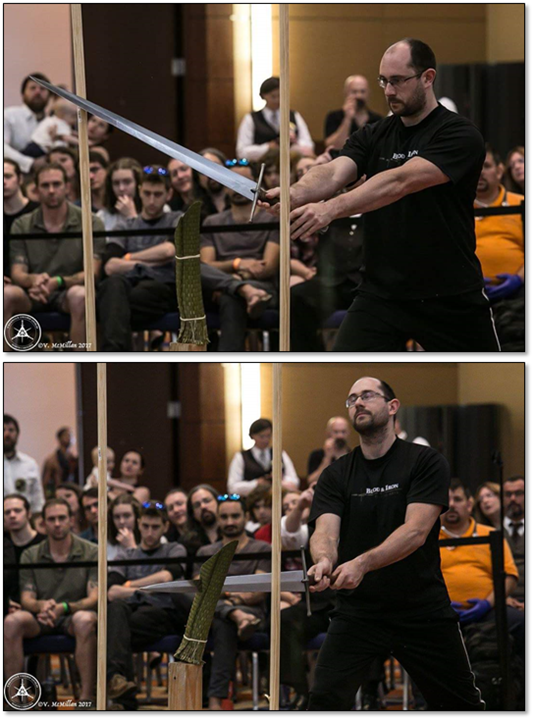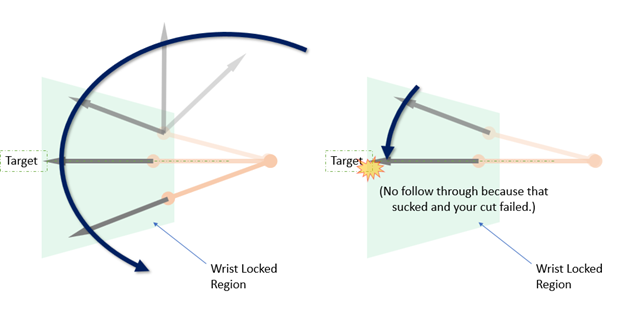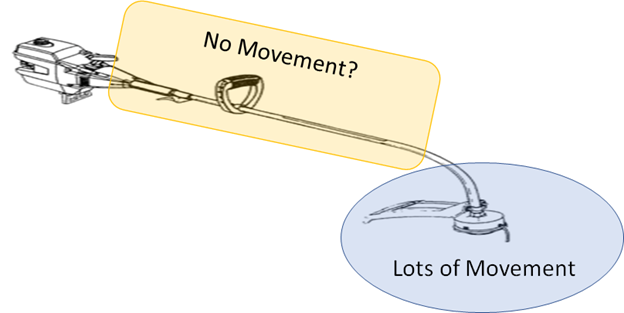
Not too long ago I published the article Accelerating the Wrist in a Cut – It Doesn’t Work! A few valid questions were raised, and they deserve answers.
Moulinet? I thought you published in English!
So, what is a moulinet? For the purpose of this discussion I’m going to call it a cut where you:
- Start from an extended point forward position.
- Rotate the sword in roughly a complete circle while keeping minimal movement from the elbow and shoulder.
- Deliver a cut.

The word cut is emphasized because I’m concerned about using mechanics which would deal significant damage to an opponent. There are many ways you can perform this movement that would be ineffective against an opponent. Moulinets show up in later period sources, at a time when there was a lot of training in the exclusive sportive domain*. It can be hard to sort out what advice on saber cutting mechanics is useful and what is more likely to be theory borrowed from touch fencing. Given the plethora of contradictory sources, we have nothing to turn to… except SCIENCE! Aka the observable and repeatable performances of modern practitioners using different mechanics.
*Through history there has never been a time when fencing didn’t have a sportive aspect. I’m referring to people who were developing technique in isolation from martial contexts.
And (once again…)
Keep in mind that delivering potentially debilitating injury to your opponent isn’t the only reason someone might throw a strike. The requirement for structure is much less important if you are simply throwing to draw first blood, to feint, to make touches in a sport competition, or don’t want to cut for any number of reasons. But that’s not what I’m talking about.
Lock On
As we recall from the previous article, this is all predicated on creating a solid structure between the wrist-arm-shoulder-whole body. This way stability of the blade can be maintained and it can do it’s cutty thing to the best of it’s cutty ability.

You can see the problem here, the sword is circling around centered on the wrist. If it’s doing that, then it isn’t engaged with the rest of the body. The trick is to lock-in and engage with your body at just the right time.

This is something that can be easier said than done. It takes quite a bit of training before you can get the feeling down (and you should do it by feel than by timing), which is why learning to cut with big full arm motions is a good starting place.
Combining Forces
Another way to understand rotating the sword before locking your structure is to sneak up behind someone who is standing peacefully and give them a shove forward. You will notice that after you give them a shove, they move a certain distance forward. And possibly down on the floor.

For contrast, try and deliver the same push to the back of someone who is walking forward. (You might need a new person, if your original subject no longer trusts their back to you.) You will notice that you can get them going a lot further for the same push. This is obviously because they were already moving, and you just had to add your force in the direction they were already going. But be thorough and push a few more people to be sure.

Hanging Parries & Short Cuts
If you try to engage your whole body in a small space it is very difficult to gain any sort of speed. Performing short cuts is quite difficult and really challenges your ability to engage your body and get absolutely everything out of it. Even at the highest levels in HEMA, under ideal conditions, people have quite a bit of difficulty with it.

If, however, the sword is allowed to get up to speed through rotation before the body engages, the whole thing becomes much simpler.

Powertrains
The last point I want to address is getting power into a wrist centric motion. Just because you are only rotating at the wrist doesn’t mean that you can’t engage the hips. For my next example, we will consider a weed whacker.

Looking at the weed whacker you can see that the bottom portion is spinning quite fast, that’s how the grass gets cut. But the middle doesn’t seem to be doing much at all.

We of course know that this isn’t true, there is a drive shaft through the middle which supplies power from the motor to the spinny part. (I hope I didn’t lose you with the technical language there.) And I hope that the human wrist/weed whacker spinny part parallel was fairly obvious. Just because we are not getting a huge movement out of the elbow and shoulder, doesn’t mean we can’t be trying to draw power from the hips through them.
Now I have to break it to you that we, very sadly, are not built like weed whackers. So you can’t use this as anything more than a conceptual example. And to actually describe what this looks like using words? Very difficult. So you just kind of have to find an instructor who can explain it to you in person.
Sorry.
More Fish To Fry

Another question brought up by a few people was in regard to the timing of joint activations. Even if it all has to lock together, is it possible to increase the overall speed? Without a doubt, by accelerating the joints at different times you can achieve a much shorter time-to-target while still maintaining a decent cutting potential. This is also the point where we really run into the limits of doing mathematical analysis.
The problem with looking at this from a theoretical point of view is that human bodies start to get really weird really fast. You have the fact that our muscles are attached in such a way as to create different forces in different parts of the motion, some joints being force-limited while some are speed-limited. And then there’s the timing required to coordinate the solid structure. In all honesty I don’t really think an analytical approach is at all appropriate to trying to figure this out. There’s just too much at play. If we want to learn more it should be with experiments and cameras watching joint accelerations, rather than with graphs and theory.
I say start from the experience base of people who cut well, combine it with people who spar well, and start building up from there. 🙂

